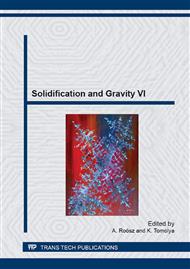[1]
G. Hoyle, Electroslag Processes, Applied Science Publishers, London, (1983).
Google Scholar
[2]
E. Plöckinger, Electroslag remelting – A modern tool in metallurgy, J. of the Iron and Steel Institute, (1973) 533-541.
Google Scholar
[3]
K. O. Yu, J. A. Domingue, G.E. Maurer and H.D. Flanders, Macrosegregation in ESR and VAR processes, J. of Metals, (1986) 46-50.
DOI: 10.1007/bf03257955
Google Scholar
[4]
V. Weber, A. Jardy, B. Dussoubs, et al., A comprehensive model of the electroslag remelting process: description and validation, Metall. Trans. B, 40B (2009), 271-280.
DOI: 10.1007/s11663-008-9208-9
Google Scholar
[5]
A. D Patel, M. Gierulal, D.J. Tallman, Bounds on model parameters for computational analysis of the ESR process, Proc. of LMPC, USA (2009), 201-211.
Google Scholar
[6]
M.J.M. Krane, M. Fahrmann, Jeff Yanke, et al., A comparison of predictions of transport phenomena in electroslag remelting to industrial data, Proc. of LMPC, France (2011), 65-72.
Google Scholar
[7]
P.C. Carman, Flow of gases through porous media, Butterworths Publisher, London, (1956).
Google Scholar
[8]
W. Schutzenhofer, G. Reiter, R. Tanzer, et al., Experimental investigations for the validation of a numerical PESR-model, Proc. of LMPC, France (2007), 49-54.
Google Scholar
[9]
Z. Jiang and Y. Dong, Solidification model for electroslag remelting process, Proc. of LMPC, France (2007), 89-94.
Google Scholar
[10]
A. Kharicha, M. Wu, A. Ludwig, B. Ofner, H. Holzgruber, CFD Modeling and simulation in materials processing, Wiley publication, USA, 2012, pp.139-148.
Google Scholar
[11]
A. Kharicha, W. Schützenhöfer, A. Ludwig and R. Tanzer, Numerical and experimental investigations on the ESR process of the hot work tool steel H11, Proc. of LMPC, USA (2009) 235-242.
Google Scholar
[12]
T.W. Clyne, W. Kurz, Solute redistribution during solidification with rapid solid state diffusion, Metall. Trans., 12A (1981), 965-971.
DOI: 10.1007/bf02643477
Google Scholar
[13]
F. R. Menter, Two-equation eddy-Viscosity turbulence models for engineering applications, AIAA Journal, 32 (8) (1994) 1598-1605.
DOI: 10.2514/3.12149
Google Scholar
[14]
M. C. Schneider and C. Beckermann, A numerical study of the combined effects of micro segregation, mushy zone permeability and flow, caused by volume contraction and thermosolutal convection, on macrosegregation and eutectic formation in binary alloy solidification, Int. J. Heat Mass Transfer, 38(18) (1995).
DOI: 10.1016/0017-9310(95)00054-d
Google Scholar
[15]
J. C. Heinrich and D. R. Poirier, Convection modeling in directional solidification, Comptes Rendus Mecanique, 332 (5-6) (2004), 429-445.
DOI: 10.1016/j.crme.2004.02.001
Google Scholar
[16]
E. J. Pickering, Macrosegregation in steel ingots: the applicability of modeling and characterization techniques, ISIJ Int., 53 (6) (2013) 935-949.
DOI: 10.2355/isijinternational.53.935
Google Scholar
[17]
H. Jacobi and K. Schwerdtfeger, Dendritic morphology of steady state unidirectionally solidified steel, Metall. Trans. A, 7A (1976) 811-819.
DOI: 10.1007/bf02644078
Google Scholar
[18]
E. Karimi Sibaki, A. Kharicha, M. Wu, A. Ludwig, H. Holzgruber, B. Ofner, M. Ramprecht, A numerical study on the influence of the frequency of the applied AC current on the electroslag remelting process, Proc. of LMPC, USA (2013), 13-19.
DOI: 10.1002/9781118830857.ch2
Google Scholar
[19]
H. Holzgruber, W. Holzgruber, A. Scheriau, et al, Investigation of the implications of the current conductive mold technology with respect to the internal and surface quality of ESR ingots, Proc. of LMPC, France (2011) 57-64.
Google Scholar
[20]
A. H. Dilawari, and J. Szekely, Heat transfer and fluid flow phenomena in electroslag refining, Metall. Trans. B, 9B (1975) 77-87.
DOI: 10.1007/bf02822674
Google Scholar
[21]
I. P. Borodin, V. A. Goryainov, V. S. Koshman, et al., Influence of solidification conditions on dendritic structure and segregation of elements in electroslag remelted ingots, Steel in the USSR (15) (1985) 533-537.
Google Scholar


